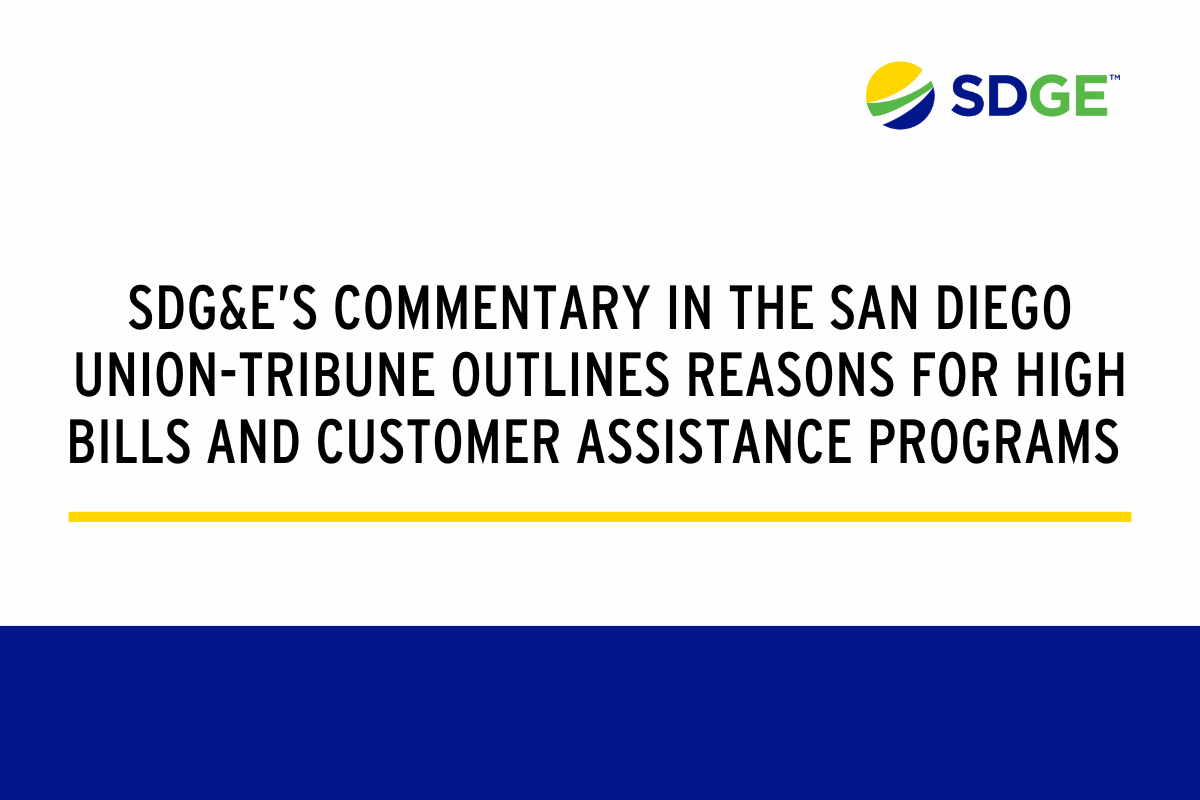Editor's Note: On Jan. 12, The San Diego Union-Tribune published a commentary by SDG&E’s VP of Customer Services that explains why natural gas prices continue to be elevated in the Western United States, as well as highlights the resources available to help our customers with high winter energy bills.
Opinion: Here’s why our winter gas bills have been high and here’s how SDG&E can help
For customers who are struggling, we offer numerous assistance programs, ranging from bill discounts and debt forgiveness to payment plans.
In recent weeks, many San Diego Gas & Electric customers have expressed anger, shock and confusion about the significant increases in their energy bill — particularly the more than doubling of their January natural gas rate, attributed to extreme gas market conditions. Some are skeptical that gas commodity prices — what SDG&E pays to buy gas from suppliers in the open market — are the primary driver of high winter bills.
At SDG&E, we understand it’s tough for our customers to hear about high bills when they are already facing higher costs for goods and services across the board.
Thankfully, high natural gas prices are not permanent. Historically, as the weather warms and gas usage declines, gas prices moderate and bills go down.
While no one wants to see their bills go up, it’s our responsibility to be transparent with our customers on why their bills are rising, and more importantly, to make sure they are aware of the assistance programs available to them. A year ago, we committed to doing a better job of communicating with our customers about rate changes and bill impacts. That’s what we’ve been striving to do. For the past few months, SDG&E has been actively communicating with our customers, alerting them to prepare for higher winter bills and new rates taking effect on Jan. 1 — and offering help.
We know much more needs to be done to provide relief, and we are working hard to come up with new solutions to support our customers — including making $1 million available in shareholder dollars to expand Neighbor-to-Neighbor, a financial assistance program for struggling customers.
Since our latest round of communications with our customers and local media last week, several questions have emerged about natural gas prices that I want to address.
Gas prices have been at historically high levels over the past year and in recent weeks with cold winter temperatures, they have soared even higher in the western United States, unlike the recent trend seen in the rest of the country or Europe. The sustained rise in gas prices accounts for more than 90% of the increase in our overall gas rate increase and the majority of the increase in our electric rate as well, since gas is used to generate electricity.
With recent changes in the market, the electricity supplied to most of our customers is actually procured by third parties known as community choice aggregators, or CCA, not SDG&E. In these instances, SDG&E delivers electricity over our infrastructure to support the community choice aggregators chosen for a certain locality. In contrast, where we still produce or procure electricity, we provide it at our actual cost without mark up. This limits costs borne by our customers. The same is true with our procurement of natural gas supplies. Whether prices are higher or lower in our region, those costs are also a direct pass through to customers.
While natural gas market prices may be lower elsewhere, they remain elevated in the West where demand is high due to cold weather and low storage levels. There is a significant differential between gas market prices on the East Coast and West Coast. According to the U.S. Energy Information Administration, several factors account for high gas prices in the West. They are:
-
Widespread, below-normal temperatures.
-
High natural gas demand for heating.
-
Reduced natural gas supplies to the West from Canada and the Rocky Mountains.
-
Reduced interstate pipeline capacity to the West Coast because of pipeline maintenance activities in West Texas.
-
Low natural gas storage levels in the West.
The current gas prices customers are seeing are for January only. Different than electric rates, gas rates are updated monthly based on forecasted market conditions. If prices come down, customers will see that reflected on their bill. Gas prices also affect electric rates because 40% of our nation’s electricity is generated from natural gas.
We know that hearing an explanation about why rates are going up doesn’t make it any easier to pay your bill. For customers who are struggling, we offer numerous assistance programs, ranging from bill discounts and debt forgiveness to payment plans. We have also recently launched a new program to provide no-cost energy efficiency upgrades to renters and owners of single-family homes. And we are working with community-based organizations to help customers obtain relief through the federally funded Low-Income Household Energy Assistance Program.
While we cannot control gas market conditions, what we want our customers to know is that we are here to help them. We will continue to maintain open communications, and we are committed to providing them with the support they need to deal with high winter bills.


